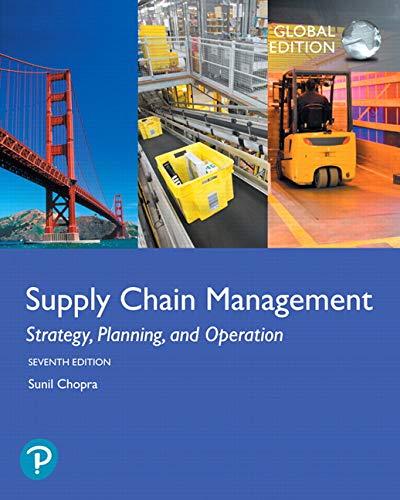We now reconsider the issue of competitors and promotions in the context of a commodity product such
Question:
We now reconsider the issue of competitors and promotions in the context of a commodity product such as detergent, for which demand is relatively stable during the year. Q&H is a major detergent manufacturer with a demand forecast for the coming year as shown in Table 9-6 (in tons).

Capacity at Q&H is governed by the number of hours the line runs. The line requires a team of 100 employees. Employees are paid $10 per hour for regular time and $15 per hour for overtime. Each ton of detergent requires 1 hour of operation of the line. The plant works 20 days a month, two shifts a day, and 8 hours per shift of regular time.
Overtime is restricted to a maximum of 20 hours per employee per month.
Each ton of detergent uses $1,000 of material. Carrying a ton of detergent in inventory from one month to the next costs $100. Q&H starts with 150 tons in inventory and wants to end with the same level. During intermediate months, Q&H wants at least 100 tons of inventory. Detergent is currently sold to retailers for $2,600 per ton. The detergent market is shared between Q&H and its competitor, Unilock.
Q&H is in the process of making its production planning and promotion decisions. Q&H wants to consider only plans without any stockouts. One option is to drop the sale price by $260 per ton (from $2,600 to $2,340) for one month in the year. The outcome of this action by Q&H is influenced by the action taken by Unilock. If neither firm promotes, the forecast demand for Q&H is as shown in Table 9-6.
 If Q&H promotes in a given month but Unilock does not, Q&H sees consumption (does not include forward buying) in that month increase by 50 percent and forward buying of 20 percent from each of the two following months. If Unilock promotes in a given month but Q&H does not, Q&H sees consumption in the month drop by 50 percent. If both promote in a given month, neither sees an increase in consumption but both see forward buying of 25 percent from each of the two following months. The debate within Q&H is whether to promote, and, if so, whether to do it in April or June. For the following questions, assume that demand for Unilock is like that of Q&H.
If Q&H promotes in a given month but Unilock does not, Q&H sees consumption (does not include forward buying) in that month increase by 50 percent and forward buying of 20 percent from each of the two following months. If Unilock promotes in a given month but Q&H does not, Q&H sees consumption in the month drop by 50 percent. If both promote in a given month, neither sees an increase in consumption but both see forward buying of 25 percent from each of the two following months. The debate within Q&H is whether to promote, and, if so, whether to do it in April or June. For the following questions, assume that demand for Unilock is like that of Q&H.
a. What is the optimal production plan for Q&H assuming no promotion by either Q&H or Unilock? What are the annual profits for Q&H?
b. What are the profits for Q&H if Unilock promotes in April but Q&H does not promote throughout the year (because it uses everyday low pricing)? What are the profits for Q&H if it promotes in April but Unilock does not promote throughout the year? Comment on the benefit from promoting versus the loss from not promoting if the competitor does.
c. What are the optimal production plan and profits if both firms promote in April? Both promote in June? Q&H promotes in April but Unilock in June? Q&H promotes in June but Unilock in April?
d. What is the best decision for Q&H if it can coordinate its decision with Unilock?
e. What is the best decision for Q&H if it wants to maximize its minimum profits no matter what Unilock does?
Step by Step Answer:

Supply Chain Management Strategy Planning And Operation
ISBN: 9781292257891
7th Global Edition
Authors: Sunil Chopra





